Dom Columba Marmion (1858-1923)
Postulation of the Cause of Blessed Columba Marmion, 3rd Abbot of Maredsous Abbey
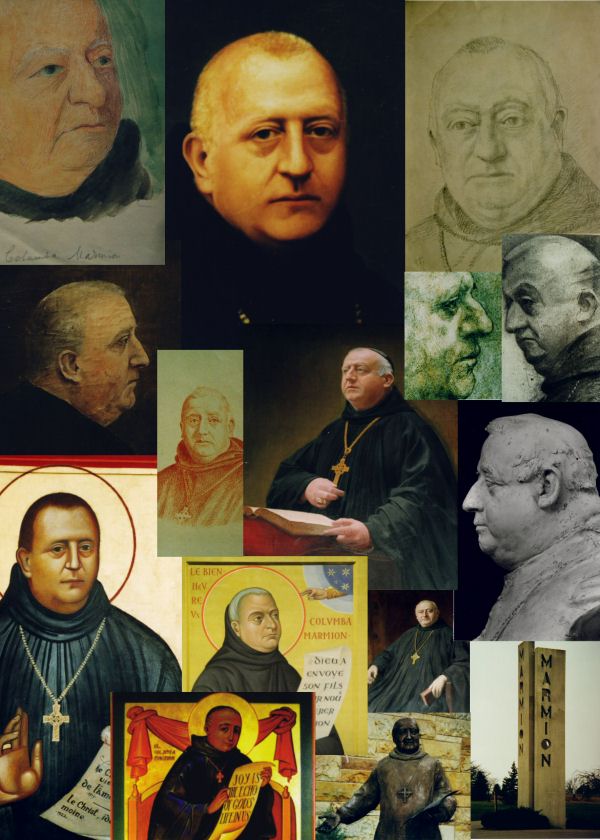
Dom Columba Marmion
Biography
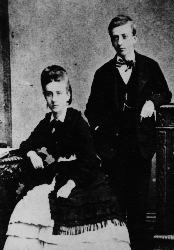 Childhood – Vocation – The call of the Cloister
Childhood – Vocation – The call of the Cloister
1858-1887
From his birth on 1st April 1858 his pious parents intended Joseph to be a priest. It was only later that he discovered his true religious vocation as a Benedictine monk.
Though remaining very Irish in character all his life, Joseph did not hesitate to leave Ireland, forsaking family and culture the better to commit himself to his vocation as a monk.
It was Maredsous, a Belgian abbey, that drew him abroad. This foundation had been established from Germany by the Abbey of Beuron in 1872, an icon of the Benedictine renewal of the time. Here he entered as a novice in 1886.
Joseph Marmion became Dom Columba at his profession in 1888. As he matured, his new monastery grew in reputation. Maredsous came to exercise an extraordinary influence in Belgium, then in Europe and eventually all over the world. The abbey's repute was based on its scholarly search for the authentic sources of the faith, and a fervent liturgy free from the devotionalism that had accrued during the previous centuries.
This was an environment in which Dom Marmion flourished. It favoured his sound spiritual formation and the priestly and missionary ardour deriving from his Irish roots.
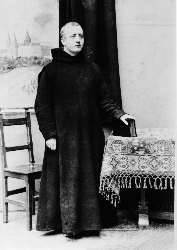 The early years in Maredsous
The early years in Maredsous
1888-1899
The early years of religious life are passed in self-effacement and humility. For Dom Marmion, older and more mature than the usual novice, this was a particularly testing time, made more trying because of the narrowness of outlook of his Master of Novices and by his absence from home.
But there were positive influences: the rapid evolution of monastic renewal deriving from Beuron; the flood of vocations at the time; the presence of remarkable creators and leaders like the brothers Wolter (the first Abbots of Maredsous), Dom Hildebrand de Hemptinne and Dom Robert de Kerchove. These men had a stimulating impact on the rhythm of monastic life and Dom Marmion’s temperament responded to their influence.
Called on to preach more frequently outside the monastery, Dom Columba's vocation as a priest blossomed, while his nomination as 'Zealator' to the novices of the abbey revealed his gift as a spiritual counsellor. This talent was to be refined in the new community of Mont César where he was sent to be one of the founding fathers.
As Master
of Ceremonies over a number of years he was
able to give expression to his love of
liturgy.
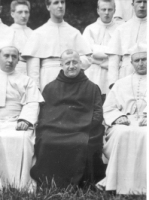 Prior of Mont-Cesar Abbey, Louvain - Spiritual Director
Prior of Mont-Cesar Abbey, Louvain - Spiritual Director
1899-1909
Dom Marmion, aged 41, had spent nearly twelve years at Maredsous when he agreed, under obedience, to take part in the founding of the new Benedictine monastery at Louvain in 1899. Here he was to have new and heavier responsibilities: direction of the 'clerics' (the young monks studying for the priesthood) and professor of theology. Soon he was appointed Prior.
Dom Marmion's temperament, that of an apostle, responded to the many requests for spiritual help and guidance from convents, mainly the Carmelites, and from male groups and congregations. Many requests came from England on account of his fluency in English.
He was sought after, too, as a confessor and spiritual director. It was during these years that a sensitivity became apparent in his contact with women.
This affinity lent a particular warmth to his spirituality.
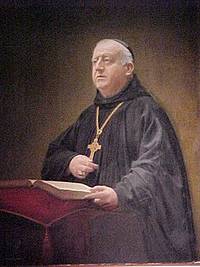 Dom Columba Marmion was elected 3rd Abbot of Maredsous
Dom Columba Marmion was elected 3rd Abbot of Maredsous
1909
His growing reputation as spiritual director during the period in Louvain, the responsibilities as Prior of that monastery, his position as confessor of Archbishop Mercier, now cardinal, his influence on the young monks of Maredsous studying at Louvain; these were some of the factors that predestined Dom Columba for the task for which he was chosen on 28th September, 1909.
Was Dom Columba suited a priori to exercise such a major responsibility?
Certain limitations of temperament in Dom Marmion's make-up existed, but these did not prevent his election. Indeed, these characteristics were to lend his response to his calling a colour hitherto unknown in the rule of Maredsous Abbey.
Following Dom Placide Wolter, the founder, and Dom Hildebrand de Hemptinne who contributed a dimension of international significance, Dom Columba brought a special spiritual radiance to Maredsous.
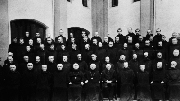 Maredsous and its new Abbot. The cloistered life.
Maredsous and its new Abbot. The cloistered life.
Dom Columba Marmion had assumed responsibility for the rule of a large monastery, then in full growth.
With a vision of the spiritual life rooted in union with Christ and a great devotion to Our Lady, the new Abbot was to inspire his community. He also achieved a balance in its spiritual development by relying on the Benedictine tradition of liturgical prayer, while tending to play down the devotional character of church practice of his time.
The new Abbot wished to serve by fostering fervour in our life with God rather than just presiding over it. This was the message of the motto he chose: Prodesse magis quam praeesse.
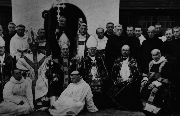 Dom Marmion in troubled times. The monastery and events in the outside world
Dom Marmion in troubled times. The monastery and events in the outside world
If he is first of all father and guide of his community, and witness that each member is truly there in search of God, the Abbot is also the representative of his monastery in the outside world.
Community life, like personal life, involves making choices. One of the first choices Dom Marmion had to face concerned a request of the Belgian Government that the monks of Maredsous should undertake a mission to Katanga in the Belgian Congo.
After considering all the circumstances, the community of Maredsous preferred to continue with its original mission of research and promotion of the sources of the faith for the benefit of the universal Church, rather than commit itself to a project involving direct evangelisation.
The Irish Abbot was a little disappointed by this decision of the majority of his community which ran counter to his own feeling for missionary enterprise, but he accepted the wish of his brothers. He supported as best he could the mission to Katanga undertaken by the newly-founded Benedictine Abbey of St.André at Bruges.
His missionary spirit was to have scope later when he became involved in the conversion to Catholicism of the Anglican Benedictine communities, male and female, of Caldey and Milford Haven in Wales.
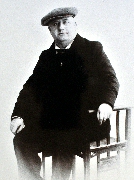 Troubles
followed by World War 1
Troubles
followed by World War 1
The outbreak of the World War 1914-1918 added to Abbot Marmion's worries.
The war proved to be his greatest trial. How could he help all his community through this troubled time, safeguarding their commitment to the spiritual life while respecting and taking into account their legitimate patriotism?
To enable the young monks to continue their formation undisturbed, he set out to find a safe place in Ireland for them.
His absence from Maredsous, followed later by his absence from the group in Ireland after May 1916, caused many misunderstandings inimical to the atmosphere of confidence essential to community life.
His health became affected by the pressure of these events. The physical and moral stress of ensuring that all his monks had the bare minimum for existence, his constant journeying under stressing circumstances, the lack of understanding that hurt him deeply, all these undermined his health. The fact that an Irishman, a British citizen, was abbot of an important Belgian monastery behind German lines made his position extremely precarious. Despite all these problems Abbot Marmion emerged with his reputation enhanced.
 After World War 1: the Dormition Affair
After World War 1: the Dormition Affair
After World War I: the Monastery of the Dormition in Jerusalem. A German foundation; what was to become of it?
With the German monks of Beuron obliged to leave the Monastery of the Dormition, Abbot Marmion considered replacing them by making a foundation from Maredsous in the Holy Land, a project encouraged by some of his young monks. Securing the Dormition Monastery for Belgium becomes a patriotic objective. Abbot Marmion's involvement reveals his skill as an international negociator.
Dom Marmion in particular, will be the founder of the Belgian Benedictine Congregation of the Annunciation, along with the Abbot of Mont-César (Louvain) and the nascent abbey of Saint-André (Bruges), This structure had become necessary so that the Belgian monasteries no longer depended on the (German) Congregation of Beuron.
Despite his
best efforts and the considerable support
brought to bear, the project did not
succeed. The German community returned to
the Monastery of the Dormition.
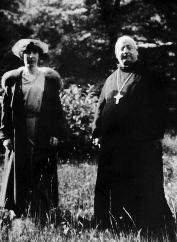 His last years: the renowned Abbot
His last years: the renowned Abbot
In demand on all sides: to preside at Church festivals, to preach, to advise. Dom Marmion did not spare himself despite the deterioration of his health, the result of the wartime years.
With Cardinal Mercier as friend and confidant, the Abbot exercised a major spiritual influence in Belgium and abroad. The visit of Queen Elizabeth of Belgium to Maredsous to spend a day with him is a measure of his reputation.
Despite his exhaustion, his readiness to agree to take the place of the Bishop of Namur leading the diocesan pilgrimage to Lourdes in September 1922 confirms both his devotion to Our Lady and his standing in the Church.
In October 1922 Dom Marmion presided at the 50th anniversary celebrations of Maredsous Abbey where he had lived, and then ruled, for 35 years. That day no one foresaw that he had but three months to live.
His
three books were already part of the staple
spiritual diet of great numbers of priests
and religious: Christ, the Life of the
Soul, Christ in his Mysteries, Christ, the
Ideal of the Monk. A fourth book Sponsa
Verbi, the work of his faithful secretary
Dom Raymond Thibaut, was published. It was
intended specially for the 'enclosed' nuns
to whom Dom Columba had so often preached.
In January 1923 Abbot Marmion caught a chill
in the course of his travels. On the 30th
January he died in his monastery succumbing
to a flu epidemic. When Abbot Marmion died,
Maredsous was at the apogee of its fame and
influence.
 Dom Columba as model for the People of God?
Dom Columba as model for the People of God?
His writings and his countenance captured in paint and photograph during his lifetime must be the starting point of personal contact with Dom Marmion for those who did not know him.
To collect his writings and gather the witness and memory of those who knew him became the work of Dom Raymond Thibaut, his faithful disciple, editor and biographer.
In 1954, the Church took over the work of researching and recording the memory of the holy Abbot Columba Marmion by starting the process of his canonisation.
The process of confirming his heroic virtues and reputation for sanctity took forty five years to complete from the initial diocesan enquiries to the final recognition by the Congregation for the Cause of Saints. The favours and miracles attributed to Dom Marmion soon justified the transfer of his remains to a tomb in the Abbey Church of Maredsous in 1963.
The Church recognised the miraculous nature of a cure resulting from prayer at his tomb. It is from here that his influence extends today: a master of spirituality for whom Jesus Christ is at the heart of our life of Faith, inspiring our spirituality as children of God.